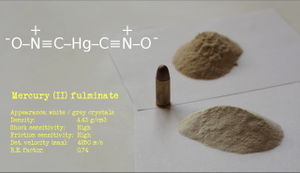Difference between revisions of "Mercury(II) fulminate"
(→Preparation) |
|||
| Line 91: | Line 91: | ||
}} | }} | ||
| Section6 = {{Chembox Hazards | | Section6 = {{Chembox Hazards | ||
| − | | AutoignitionPt = 170 °C | + | | AutoignitionPt = 170 °C (338 °F; 443 K) |
| ExploLimits = | | ExploLimits = | ||
| ExternalMSDS = [http://www.t3db.ca/system/msds/attachments/000/000/770/original/T3D0340.pdf?1413587571 CPCB] | | ExternalMSDS = [http://www.t3db.ca/system/msds/attachments/000/000/770/original/T3D0340.pdf?1413587571 CPCB] | ||
| Line 135: | Line 135: | ||
==Projects== | ==Projects== | ||
*Make blasting caps | *Make blasting caps | ||
| + | *Compound collecting | ||
==Handling== | ==Handling== | ||
| Line 148: | Line 149: | ||
Addition of an acid, such as hydrochloric acid will convert it into [[mercury(II) chloride]], which should be converted to an insoluble form, such as [[mercury sulfide]] and then taken to a hazardous chemical center for disposal. | Addition of an acid, such as hydrochloric acid will convert it into [[mercury(II) chloride]], which should be converted to an insoluble form, such as [[mercury sulfide]] and then taken to a hazardous chemical center for disposal. | ||
| − | DO NOT POUR IT DOWN THE DRAIN! | + | DO NOT POUR IT DOWN THE DRAIN! EVER! |
==References== | ==References== | ||
Latest revision as of 19:27, 16 May 2023
 Mercury(II) fulminate, grey and white samples
| |
| Names | |
|---|---|
| IUPAC name
Mercury(II) fulminate
| |
| Other names
Fulminated mercury
Mercury fulminate | |
| Properties | |
| HgC2N2O2 | |
| Molar mass | 284.624 g/mol |
| Appearance | White-gray powder |
| Density | 4.42 g/cm3 |
| Melting point | 160 °C (320 °F; 433 K) (explodes) |
| Boiling point | 356.6 °C (673.9 °F; 629.8 K) (explodes) |
| 0.0704 g/cm3 (at 20 °C) 0.1738 g/cm3 (at 49 °C) | |
| Solubility | Soluble in ammonia, ethanol |
| Solubility in chloroform | 0.0066 g/cm3 (at 60 °C) |
| Solubility in diethyl ether | 0.0028 g/cm3 (at 34 °C) |
| Hazards | |
| Safety data sheet | CPCB |
| Related compounds | |
| Related compounds
|
Silver fulminate |
| Except where otherwise noted, data are given for materials in their standard state (at 25 °C [77 °F], 100 kPa). | |
| Infobox references | |
Mercury(II) fulminate, or simply mercury fulminate is a primary explosive, sensitive to friction and shock, widely used in the past as trigger for other explosives in percussion and blasting caps, now largely replaced by other less toxic, more stable and less corrosive primers, such as lead styphnate or tetrazene derivatives. It has the chemical formula Hg(CNO)2.
Although some sources identify mercury fulminate as mercury cyanate, this is incorrect, as fulminates have a direct metal-carbon bond, while cyanates have an ionic bond between metal and the oxygen from the cyanate group.
Contents
Properties
Chemical
Mercury fulminate explodes when subjected to strong impact, friction, heat or electric arc, releasing a cloud of powdered mercury, nitrogen and carbon oxides.
- Hg(CNO)2 → Hg + 2 CO + N2
Physical
Mercury(II) fulminate is a grayish solid powder, insoluble in water, and slightly more soluble in organic solvents and ammonia.
Explosive
Mercury(II) fulminate is a primary explosive material. It shows high sensitivity to shock, friction and heat, though unlike its silver counterpart, it's less sensitive and simply throwing a small bag of Hg(CNO)2 against a strong surface will not result in detonation. It has a detonation velocity of 4250 m/s.
Availability
Mercury(II) fulminate is not sold by any chemical supplier due to its hazards and has to be made.
Preparation
Mercury fulminate can be prepared prepared by dissolving elemental mercury in 70% nitric acid, followed by the addition of ethanol to the solution.[1] To make the resulting powder whiter, CuCl is used.[2]
Projects
- Make blasting caps
- Compound collecting
Handling
Safety
Mercury(II) fulminate is sensitive to shock, friction and heat. Its decomposition products contain carbon dioxide/monoxide, nitrogen and mercury vapors, with the latter being extremely toxic.
Mercury fulminate is very toxic and ingestion may cause death.
Storage
Mercury(II) fulminate should only be stored for very short periods of time and used as soon as possible.
Disposal
Addition of an acid, such as hydrochloric acid will convert it into mercury(II) chloride, which should be converted to an insoluble form, such as mercury sulfide and then taken to a hazardous chemical center for disposal.
DO NOT POUR IT DOWN THE DRAIN! EVER!